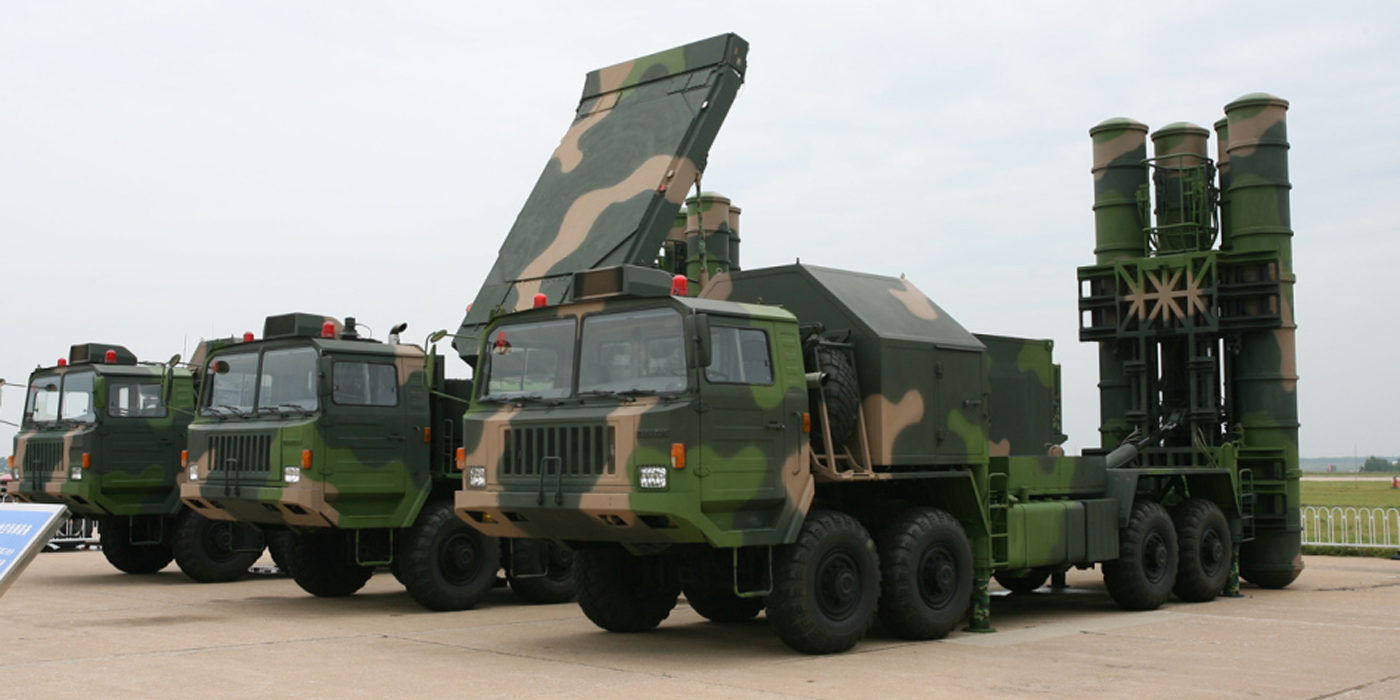Quick Facts
| PRC Designation | HQ-9 |
| Variants | HQ-9A, HQ-9B, HQ-9C, HHQ-9, HHQ-9A, FD-2000, FT-2000 |
| Mobility and Role | Ground-based/road-mobile; long-range air and missile defense |
| Range | 100km (FT-2000), 200 km (HQ-9), 250 km (HQ-9A), or 300 km (HQ-9B) |
| Sensors |
HT-223 Multifunction radar for illuminating and homing -X-Band -120 km target detection range -90 km target tracking range |
| Targets | Low-flying aircraft, cruise missiles, air-to-ground missiles, and tactical ballistic missiles |
| Status/Exports | Operational; Exported to Algeria, Bangladesh, Iran, Iraq, Pakistan, and Turkmenistan |
| Designer/Producer | China Aerospace Science and Industry Corporation (CASIC) |
Overview
The Hong Qi-9 (HQ-9) is a ground-based, extended range, mobile air defense system developed by the People’s Republic of China and based extensively on the Russian S-300 PMU system.[i]Since its initial development in 1997, HQ-9 has undergone significant upgrades and spurred naval, anti-radiation, and export-designated variants. Most land-based HQ-9 variants can hit targets at ranges of up to 200 kilometers and altitudes of up to 30,000 meters.[ii]While its single-shot kill probability is as high as 90 percent against airplanes, it may be much lower—about 30 percent—against ballistic missiles.[iii]
| Variant | Modifications |
| HQ-9A | Improved electronic equipment and software provide the 9A with higher accuracy and probability of kill[iv] |
| HQ-9B | Longer 300 km range; an additional seeker provides semi-active radar homing and infrared homing modes[v] |
| HQ-9C | Currently in development; incorporates fully active radar homing[vi] |
| HHQ-9 | Naval variant identical to HQ-9; launched from VLS tubes in Lanzhou class destroyers[vii] |
| HHQ-9A | Naval variant identical to HQ-9A |
| FD-2000 | Identical to original HQ-9, but designed for export with minor electronic improvements |
| FT-2000 | Anti-radiation system; range of up to 100 km |
Each HQ-9 launcher contains four missiles stored in individual containers and is transported on Taian TA5380 8×8 high mobility chassis.[viii]HQ-9’s standard HT-233 engagement radar can track 100 targets and engage 50 of them at a range of 100 km.[ix]A normal PLA HQ-9 battery includes “a command vehicle, six control vehicles, 6 targeting radar vehicles, 6 search-radar vehicles, 48 missile-launch vehicles, and 192 missiles.”[x]HQ-9 can use a variety of radar sensors to detect different targets, including ballistic missiles and stealth objects. A battery may include HT-233 engagement radar, H-200 mobile engagement radar, and a number of search radars like the Type 120 low altitude acquisition radar, Type 305A 3D acquisition radar, or Type 305B 3D acquisition radar.[xi]
Strategic Implications
HQ-9 represents the backbone of the Chinese missile defense program. Its complicated lineage reflects the changing demands and constraints of Chinese air defenses over time. The original HQ-9 was reportedly born out of the United States’ technological superiority and victory in the Gulf War, which awakened Beijing to the fact that its air defenses were lacking against precision-guided munitions, stealth aircraft, and airborne C4I.[xii]Original HQ-9 interceptors traveled slower than comparable Western or Russian systems, in part due to the HQ-9 missile’s massive 180-kg warhead. However, recent upgrades like the HQ-9A and HQ-9B offer faster, lighter interceptors. Modern HQ-9B interceptors use inertial guidance during flight and active radar homing during their terminal phase, enhancing the probability of kill against several targets. HQ-9 fills the role of medium-long range defense in Chinese aerial defense systems, though in recent years it has been replaced by the HQ-18.
Timeline
November 30, 2016:Iraq finalizing $2.5 billion deal with China for HQ-9 SAM.[xiii]
2016:HQ-9B presented at an exhibition in Zhuhai, China.[xiv]
September 2013: China wins Turkey’s T-LORAMIDS program contract to import twelve HQ-9 systems.[xv]
2013: China begins production of the HQ-9A.
March 2009: China unveils the FD-2000 export variant of the HQ-9 at the Africa Aerospace and Defence Exhibition in Cape Town.[xvi]
2006: HQ-9B is tested for the first time, featuring a dual seeker with both semi-active and infrared homing.[xvii]
2000: Chinese documents label the need for “HQ-19,” a vastly upgraded version of the HQ-9.
1999: HQ-9A is tested for the first time.[xviii]
1997: HQ-9 achieves initial operational capacity.[xix]
1994: China purchases 120 additional S-300PMU missiles from Russia.
1993: Israel allegedly sells China a Patriot missile system or technical information.
1991: China purchases 4-6 S-300PMU batteries from Russia.
Recent News
References
[i]https://www.globalsecurity.org/military/world/china/hq-9.htm
[ii]http://www.deagel.com/Artillery-Systems/HQ-9A_a001834001.aspx
[iii]https://www.globalsecurity.org/military/world/china/hq-9-tech.htm
[iv]http://rbase.new-factoria.ru/missile/wobb/hq-9/hq-9.shtml
[v]http://www.deagel.com/Defensive-Weapons/HQ-9B_a001833002.aspx
[vi]http://www.military-today.com/missiles/hq9.htm
[vii]http://rbase.new-factoria.ru/missile/wobb/hq-9/hq-9.shtml
[viii]http://www.military-today.com/missiles/hq9.htm
[ix]https://www.armyrecognition.com/china_chinese_army_missile_systems_vehicles/hq-9_ground-to-air_medium_range_air_defense_missile_technical_data_sheet_specifications_pictures.html
[x]https://www.armyrecognition.com/china_chinese_army_missile_systems_vehicles/hq-9_ground-to-air_medium_range_air_defense_missile_technical_data_sheet_specifications_pictures.html
[xi]Ibid.
[xii]https://www.globalsecurity.org/military/world/china/hq-9.htm
[xiii]https://quwa.org/2016/11/30/iraq-reportedly-seeking-hq-9-long-range-surface-to-air-missiles/
[xiv]http://rbase.new-factoria.ru/missile/wobb/hq-9/hq-9.shtml
[xv]https://thediplomat.com/2013/09/why-turkeys-buying-chinese-missile-systems/
[xvi]https://www.upi.com/China-exports-new-surface-to-air-missile/30271237410000/
[xvii]http://www.military-today.com/missiles/hq9.htm
[xviii]http://www.military-today.com/missiles/hq9.htm
[xix]http://www.deagel.com/Defensive-Weapons/HQ-9_a001833001.aspx

